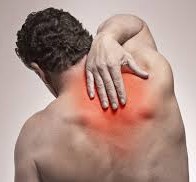A pain in the thorax - Sports Medicine Doctor Malta - Dr Danica Bonello Spiteri
Main menu:
A pain in the thorax
A pain in the thorax (First published on vida magazine on December 2013)
Thoracic (upper spine) pain is a very common cause of constant pain in between the scapular (wing bones)area. This is since it is a region that contributes to the stability of the spine, as it articulates with the ribs and various vertebral joints.
Thoracic spine pain is a frequently overlooked cause of pain and disability in both the active person, and even more so in the sedentary person, especially with desk based, stationary posture occupations/hobbies.
One must be careful to exclude any sinister cause of sudden new onset of thoracic spine pain, such as cancers, dissecting aneurysms, osteoporotic fractures to name a few, where the management would take a different course. This article will be dealing with thoracic spine pain that is of musculoskeletal origin, assuming that any serious illness has been excluded.
Pain is usually located between the scapuale and can be uni/bilateral, arising either through a sudden movement, or else of gradual onset without any particular incident. Pain is usually reproduced through active movement, especially rotation and lateral flexion of the thoracic spine. There are 12 thoracic vertebrae in the spine, and the upper and lower 4 vertebrae (T1-
Any signs of tingling, numbness or altered sensation are also important symptoms that may be related to thoracic spine problems.
Problems in the thoracic spine may also radiate to other regions in the body, such as the shoulder, the cervical (neck) spine, the buttock and hip.
Radiation of pain into the neck (cervical spine) is usually result of tight, contracted muscles, mainly the trapezius muscles. This is also a very common cause of recurrent headaches on the posterior aspect of the head, as the tight muscles tend to pull on the fascia that covers the scalp, which are attached to the said muscles.
Other commonly tight, contracted muscles that are responsible for pain in between the scapulae are the rhomboid muscles. The rhomboid muscles are responsible for keeping our scapuale in place and they attach between the thoracic vertebrae to the scapulae.
Any occupations or hobbies, where the body is maintained in a constant, more or less, static position, such as sitting down at a desk, result in the rhomboids and trapezius muscles remaining in a constantly contracted tight position. This causes constant pain, and a resultant tight, stiff thoracic spine.
When the tight muscles are palpated, various rope like, painful lumps can be felt easily and the same pain is reproduced. They are referred to as trigger points (very painful when pressed!). Interestingly, any type of scans (MRI, CT scan, ultrasound scans, x-
Treatment is aimed towards restoring normal function; including good movement within the thoracic spine, relaxation of the tight muscles, and switching off the painful trigger points.
A mixture of spine manipulation, musculoskeletal acupuncture (not chinese acupuncture), and restorative exercises are the mainstay of treatment.
However, muscles tend to maintain 'muscle memory', so the problem may recur over time. Hence, it is essential that the treating clinican also targets the cause of the problem, so that the patient can then understand why the pain occurred in the first place, and then can make adjustments/alterations to decrease the chance of recurrent episodes.
This latter aspect is often difficult to alter, as humans tend to be creatures of habit, and unknowingly we tend to repeatedly take certain postures and repeated movements. But through increasing the awareness, this can be adjusted, and will go a long way towards ensuring the thoracic pain does not recur.

For direct contact or to book a consultation please send an email on:
drdanica@sportsmedicinemalta.com
For direct contact or to book a consultation please send an email on:
drdanica@sportsmedicinemalta.com